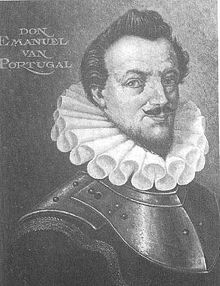Manuel of Portugal
Manuel of Portugal (* 1568 in Tangier , † June 22, 1638 in Brussels ) was a Portuguese - Dutch nobleman.
origin
Manuel of Portugal was born as the son of the Portuguese pretender António von Crato and an "Anna Barbosa". Because of his religious consecration , the father was not allowed to marry. After the failed attempt to gain the Portuguese throne in 1580, António lived in France and England . His son, Manuel of Portugal, is also known as Emanuel (I.) in his Dutch context.
family
First marriage
Manuel of Portugal was married to Emilia von Oranien-Nassau (* 1569, † 1629), a daughter of Prince Wilhelm I of Oranien-Nassau (* 1533; † 1584) and Princess Anna of Saxony ( * 1544; † 1577). The bride's family was one of the most prominent representatives of Calvinism in Europe, the bridegroom was a Roman Catholic . The family resisted the marriage, but this did not prevent the engaged couple from secretly marrying a Roman Catholic priest . Manuel then had to flee to Wesel . Emilia, initially under house arrest, was only able to follow him in December 1597.
Their marriage revealed:
- Maria Belgica (* before October 12, 1598; † July 28, 1647), married in June 1629 to Colonel Theodor Croll († 1640 in Venice [murdered]), Quartermaster General of Duke Odoardo I Farnese of Parma.
- Manuel António (born February 24, 1600 in Delft , † October 27, 1666 in Schagen ).
- Emilia Louise (born June 1603 in Delft; † October 29, 1670), unmarried
- Christoph Wilhelm Ludwig (* 1604; † 7 July 1660), military, 1624 chief of the Guard of Moritz von Oranien , Knight of Malta , married Anna Maria von Moutéleone.
- Anna Louise (* before May 3, 1605; † April 5, 1669), unmarried.
- Juliana Katherina (* approx. 1607; † July 22, 1680), unmarried
- Eleonora Mauritia (* before May 10, 1609; † June 25, 1674), married Count Georg Friedrich von Nassau-Siegen on June 4, 1647 in The Hague .
- Sabina Delphica (* 1612; † July 20, 1670), unmarried.
Because of the way the marriage came about, Manuel and Emilia lived in constant financial need for the first few years of their marriage. It was not until 1608, through the mediation of Prince Philipp Wilhelm of Orange-Nassau, that a reconciliation between Manuel and Emilia on the one hand and the governor of Holland, Prince Moritz of Orange , on the other, came about . They received a pension and were assigned residences. But life at the governor's court was not easy for the two of them, as Manuel was cut socially as a Catholic. He then entered into secret negotiations with the governors of the Catholic Spanish Netherlands , Infanta Isabella Clara Eugenia and her husband, Archduke Albrecht VII of Austria , who assured him a higher allowance than he received from the Orange. When, after the death of Prince Moritz in 1625, tensions with his successor, Prince Friedrich Heinrich von Orange-Nassau, increased, Manuel went to Brussels. His wife, who saw the father of Isabella, King Philip II of Spain, as the driving force behind the murder of her father, could not make up her mind to follow him and went with her daughters to Geneva , where she died in 1629.
The fate of the family's daughters was overshadowed by a scandal. The eldest, Maria Belgica, was originally supposed to marry a margrave of Baden, but ran away with Colonel Theodor Croll, who was in the service there, which reduced the chances of her younger sisters getting married in society at the time. Only Eleonora Mauritia was an exception.
Second marriage
On April 3, 1630, Manuel married for the second time in the palace chapel in Brussels. The bride was Luisa de Osorio, a lady-in-waiting to Isabella, from old Spanish nobility. At the court of Isabella both held a prominent position.
Manuel died on June 22, 1638 in Brussels, where he was also buried. His second wife survived him.
Individual evidence
literature
- AWE Dek: De afstammelingen van Juliana van Stolberg tot aan het jaar van de Vrede van Munster . In: Mirror of History. Zaltbommel 3.1968, 7/8.
- JLJ van Kamp: Nog een tak afstammelingen van Willem de Zwijger . In: De nederlandsche Leeuw . 's-Gravenhage 74.1957, 9 (Sept), columns 266-287, 306-316. ISSN 0028-226X
- Reinhard Suchier : Genealogy of the Hanauer count house. in: Festschrift of the Hanau History Association for its 50th anniversary celebration on August 27, 1894. Hanau 1894.
| personal data | |
|---|---|
| SURNAME | Manuel of Portugal |
| ALTERNATIVE NAMES | Emanuel of Portugal; Emanuel I of Portugal |
| BRIEF DESCRIPTION | Dutch-Portuguese nobleman |
| DATE OF BIRTH | 1568 |
| PLACE OF BIRTH | Tangier |
| DATE OF DEATH | June 22, 1638 |
| Place of death | Brussels |

